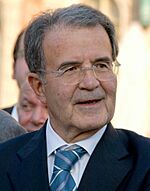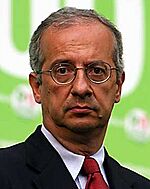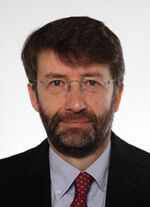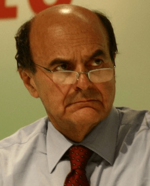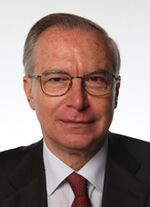Democratic Party (Italy) facts for kids
Quick facts for kids
Democratic Party
Partito Democratico
|
|
|---|---|
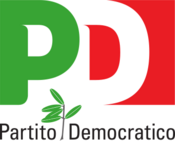 |
|
| Abbreviation | PD |
| Secretary | Elly Schlein |
| President | Stefano Bonaccini |
| Founded | 14 October 2007 |
| Merger of |
|
| Headquarters | Via Sant'Andrea delle Fratte 16 (Largo del Nazareno), Rome |
| Newspaper |
|
| Youth wing | Young Democrats |
| Membership (2024) | |
| Ideology | Social democracy |
| Political position | Centre-left |
| National affiliation | Centre-left coalition |
| European affiliation | Party of European Socialists |
| International affiliation | Progressive Alliance |
| European Parliament group | Progressive Alliance of Socialists and Democrats |
| Parliamentary group | PD–IDP |
| Colours | Red Green |
| Chamber of Deputies |
71 / 400
|
| Senate |
37 / 205
|
| European Parliament |
21 / 76
|
| Regional Councils |
212 / 896
|
| Conference of Regions |
4 / 21
|
The Democratic Party (Italian: Partito Democratico, PD) is a big political party in Italy. It believes in social democracy, which means it supports fairness and equality for everyone. The party's current leader, called the Secretary, is Elly Schlein. She was chosen in a special election in 2023. The party's President is Stefano Bonaccini.
The PD started in 2007. It was formed when several different parties on the centre-left side of politics decided to join together. These parties had worked together before in a group called The Olive Tree. The two main parties that merged were the Democrats of the Left (DS) and Democracy is Freedom – The Daisy (DL). The DS had roots in the Italian Communist Party, while the DL was inspired by Catholic ideas.
From 2013 to 2018, three different Prime Ministers from the PD led the Italian government. These were Letta, Renzi, and Gentiloni. In the 2018 election, the PD became the second-largest party. They later joined the government again in 2019 and 2021. After the 2022 election, the PD became an opposition party. Today, the PD is one of the two main political parties in Italy.
Many important politicians have been part of the Democratic Party. This includes former leaders like Walter Veltroni and Enrico Letta. Two former Presidents of Italy, Giorgio Napolitano and Sergio Mattarella, were also members. As of 2024, the PD leads the governments in four Italian regions: Emilia-Romagna, Tuscany, Apulia and Campania.
Contents
- Party History
- Party Ideas
- Where the Party is Strong
- Election Results
- Party Leaders
- Symbols
- See also
Party History
How the Party Started
After some big political changes in Italy in the 1990s, many left-wing and centre-left groups wanted to unite. In 1995, Romano Prodi started a group called The Olive Tree. This group included several parties and won the 1996 election, making Prodi the Prime Minister.
Over time, the main parties in The Olive Tree changed. The Italian Communist Party became the Democrats of the Left (DS). Other parties, including those with Catholic roots, merged to form Democracy is Freedom – The Daisy (DL). These two big parties, along with some smaller ones, decided to create a single, larger party.
Forming the Democratic Party
The idea of a single "Democratic Party" grew stronger, especially after the 2006 election. Eight parties agreed to merge into the PD. The DS and DL were the biggest ones. The DS had a big meeting where most members voted to join the new party. Some members who disagreed left to form a new party.
On October 14, 2007, the Democratic Party was officially created. They held an open election where over three million people voted for their first leader. Walter Veltroni won with about 75% of the votes. He became the first Secretary of the PD. A new logo was also revealed, showing an olive branch and the letters "PD" in the colors of the Italian flag: green, white, and red. These colors represent different ideas that came together in the party.
Early Leaders and Elections
After the government fell in 2008, the PD faced an election. They formed an alliance with other parties. In the 2008 election, the PD and its allies lost to the centre-right parties. Veltroni then formed a "shadow cabinet" to act as an opposition.
After a tough election in Sardinia in 2009, Walter Veltroni stepped down. His deputy, Dario Franceschini, became the temporary leader.
In the 2009 European election, the PD got 26.1% of the votes. This was an important test for the new party.
Pier Luigi Bersani's Leadership
Later in 2009, the party held another election for a new leader. Pier Luigi Bersani won with about 53% of the votes. Some members who felt the party was moving too far to the left left to form new parties.
In the 2010 regional elections, the PD lost control of four regions but kept six others. In 2011, Bersani tried to form a new alliance with other centre-left parties. However, this alliance broke apart when the PD supported a new government led by Mario Monti.
The 2013 Election
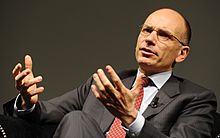
Before the 2013 general election, the PD held a primary election to choose their candidate for Prime Minister. Bersani won this primary, beating Matteo Renzi, who was the mayor of Florence at the time.
However, in the 2013 general election, the PD and its allies did not do as well as expected. They won the most votes in the Chamber of Deputies but did not get enough seats in the Senate to govern alone. This meant they couldn't form a government easily. Bersani tried but failed.
After this, Bersani resigned as party secretary. Enrico Letta, who was the party's deputy secretary, became the Prime Minister. He led a "grand coalition" government that included parties from both the centre-left and centre-right.
Guglielmo Epifani's Leadership
After Bersani's resignation, Guglielmo Epifani was chosen as the new party secretary in May 2013. He was a former trade union leader. His main job was to lead the party until a new leader could be properly elected later that year. The PD had some success in local elections during his time.
Matteo Renzi's Leadership
In December 2013, Matteo Renzi was elected as the new Secretary of the PD. He won with a large majority of the votes. Renzi wanted to bring new ideas and changes to the party and the country.
In February 2014, Renzi became Prime Minister, leading a government with a similar group of parties as Letta. The PD also officially joined the Party of European Socialists (PES), a group of social democratic parties in Europe.
Renzi as Prime Minister
In the 2014 European Parliament election, the PD achieved a huge success, getting over 40% of the votes. This was one of the best results for an Italian party in a long time. This success helped Renzi get an important job for one of his ministers in the European Commission.
In 2015, Sergio Mattarella, a founding member of the PD, was elected President of Italy. During Renzi's time as Prime Minister, some politicians from other parties joined the PD, increasing its numbers in Parliament. However, some members from the left-wing of the PD also left to form new parties.
After losing a vote on changing the Italian constitution in 2016, Renzi resigned as Prime Minister. Paolo Gentiloni, another member of the PD, took over as Prime Minister. Renzi also resigned as party secretary in 2017 to run for the leadership again.
In the 2017 leadership election, Renzi won again. However, a group of left-wing members left the PD to form a new party called Article 1 – Democratic and Progressive Movement (MDP).
The 2018 Election
In the 2018 general election, the PD had its worst result ever, getting only 18.7% of the votes. After this defeat, Renzi resigned as secretary. The party then went into opposition after being in government for seven years.
Maurizio Martina's Leadership
Maurizio Martina became the party's secretary in July 2018. He led the party while they prepared for a new leadership election in 2019.
Nicola Zingaretti's Leadership
In March 2019, Nicola Zingaretti was elected as the new Secretary of the PD. He won with 66% of the votes. Former Prime Minister Gentiloni became the party's new president.
In the 2019 European election, the PD came in second place, after the League. Later that year, David Sassoli, a member of the PD, was elected President of the European Parliament.
Working with the Five Star Movement
In August 2019, the PD decided to form a new government with the Five Star Movement. This was a big change, as they had been rivals before. Giuseppe Conte continued as Prime Minister. Some members, like Carlo Calenda, left the PD because they disagreed with this alliance.
In September 2019, Matteo Renzi also left the PD to start his own party, Italia Viva. This caused many members of Parliament to leave the PD.
In early 2020, the PD's candidate, Stefano Bonaccini, won the regional election in Emilia-Romagna, a strong area for the party.
Joining Draghi's Government
In January 2021, the government led by Conte faced a crisis. After some discussions, Mario Draghi was asked to form a new government. The PD decided to join this new "national unity" government, which also included parties from the centre-right. The PD had three ministers in Draghi's government.
Enrico Letta's Leadership
In March 2021, Nicola Zingaretti resigned as secretary. Many important members of the PD asked former Prime Minister Enrico Letta to become the new leader. Letta accepted and was elected secretary on March 14, 2021.
In October 2021, the PD and its allies won local elections in many major Italian cities, including Milan, Bologna, Naples, Rome, and Turin.
The 2022 Election
In July 2022, Draghi's government faced another crisis and eventually resigned. This led to a new general election. The PD ended its alliance with the Five Star Movement.
In the 2022 election, the PD got 19.1% of the votes. The centre-right coalition won the election, and Giorgia Meloni became Prime Minister. After this defeat, Letta announced he would step down, and a new leadership election was planned for 2023.
Elly Schlein's Leadership
The 2023 leadership election was a big moment for the PD. Stefano Bonaccini and Elly Schlein were the main candidates. Schlein, who was Bonaccini's former vice president in Emilia-Romagna, surprisingly won the election on February 26, 2023, becoming the new Secretary. She was officially appointed on March 12, and Bonaccini was elected as the party's president. In June 2023, Article One, a party that had split from the PD earlier, merged back into it.
In the 2024 European Parliament election, the PD got 24.1% of the votes, coming in second place.
Party Ideas
The PD is a "big tent" party, meaning it includes many different ideas and groups. It is a centre-left party, influenced by social democracy (fairness for all) and the Christian left (social justice based on Christian values). The party's founders believed in working together, like the Italian Communist Party and Christian Democracy did in the past.
The PD focuses on national unity, progressivism, social liberalism (supporting individual freedoms and social justice), environmental issues, fair taxes, and being strongly pro-European.
Over time, the party's ideas have changed a bit. Under Matteo Renzi, the party adopted some more economic liberal ideas. However, under later leaders like Elly Schlein, the party has moved more towards left-wing and environmental policies.
The PD generally supports including immigrants in society. However, since 2017, the party has also adopted stricter policies on immigration and public safety, which has led to some debate within the party.
Different Groups within the Party
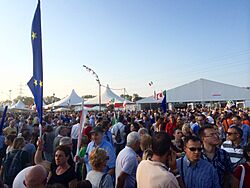
The PD is made up of several different groups, or "factions," each with slightly different ideas:
- Social Democrats: This is the largest group. They focus on workers' rights and social issues. Many came from the former Democrats of the Left. Some are traditional social democrats, while others are more influenced by modern ideas like those of the British Labour Party.
- Christian Left: These members are inspired by Christian values and social justice. Many came from the left-wing of the old Christian Democracy party.
- Social Liberals: This group supports individual freedoms and social justice. Some came from older liberal or republican parties.
- Green Politics: This group focuses on environmental issues and sustainable policies.
Some leaders, like Matteo Renzi, brought new ideas that were a mix of liberal economic policies and popular appeals. After Renzi left the party, some of his supporters stayed in the PD.
International Connections
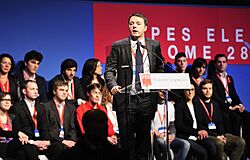
When the PD first started, there was a discussion about which European political group to join. The former Democrats of the Left generally wanted to join the Party of European Socialists (PES), while others preferred the European Democratic Party.
After the 2009 European election, the PD's members of the European Parliament decided to join the Progressive Alliance of Socialists and Democrats (S&D) group. In 2012, the PD also became a founding member of the Progressive Alliance (PA), a global group for progressive parties. In 2014, the PD officially became a full member of the PES.
Where the Party is Strong
Like the parties it came from, the PD is strongest in Central Italy and in big cities. The party currently leads the governments in six regions and in major cities like Rome, Milan, Naples, Turin, Bologna, Florence, and Bari.
In past general elections (2008 and 2013), the PD got its best results in regions like Tuscany, Emilia-Romagna, Umbria, and Marche. The party is generally stronger in Northern and Central Italy than in Southern Italy.
The 2014 European election was a huge success for the PD, where they got over 40% of the votes nationwide. However, the 2018 general election was a big defeat, with the party's support dropping significantly.
The chart below shows the PD's results in general and European Parliament elections since 2008.
Election Results
Italian Parliament
| Election | Leader | Chamber of Deputies | Senate of the Republic | ||||||||
|---|---|---|---|---|---|---|---|---|---|---|---|
| Votes | % | Seats | +/– | Position | Votes | % | Seats | +/– | Position | ||
| 2008 | Walter Veltroni | 12,434,260 | 33.2 |
217 / 630
|
– | 2nd | 11,052,577 | 33.7 |
118 / 315
|
– | 2nd |
| 2013 | Pier Luigi Bersani | 8,934,009 | 25.4 |
297 / 630
|
8,400,255 | 27.4 |
112 / 315
|
||||
| 2018 | Matteo Renzi | 6,161,896 | 18.8 |
112 / 630
|
5,783,360 | 19.1 |
54 / 315
|
||||
| 2022 | Enrico Letta | 5,356,180 | 19.1 |
69 / 400
|
5,226,732 | 19.0 |
40 / 200
|
||||
European Parliament
| Election | Leader | Votes | % | Seats | +/– | Position | EP Group |
|---|---|---|---|---|---|---|---|
| 2009 | Dario Franceschini | 8,008,203 | 26.1 |
21 / 72
|
New | 2nd | S&D |
| 2014 | Matteo Renzi | 11,203,231 | 40.8 |
31 / 73
|
|||
| 2019 | Nicola Zingaretti | 6,089,853 | 22.7 |
19 / 76
|
|||
| 2024 | Elly Schlein | 5,646,296 | 24.1 |
21 / 76
|
Regional Councils
| Region | Election year | Votes | % | Seats | +/− | Status in legislature |
|---|---|---|---|---|---|---|
| Aosta Valley | 2020 | 10,106 (3rd) | 15.3 |
7 / 35
|
|
Majority |
| Piedmont | 2024 | 395,710 (2nd) | 23.9 |
13 / 51
|
|
Opposition |
| Lombardy | 2023 | 628,774 (2nd) | 21.2 |
18 / 80
|
|
Opposition |
| South Tyrol | 2023 | 9,707 (8th) | 3.5 |
1 / 35
|
|
Opposition |
| Trentino | 2023 | 38,689 (1st) | 16.6 |
7 / 32
|
|
Opposition |
| Veneto | 2020 | 244,881 (3rd) | 11.9 |
7 / 51
|
|
Opposition |
| Friuli-Venezia Giulia | 2023 | 65,143 (4th) | 16.5 |
10 / 49
|
|
Opposition |
| Emilia-Romagna | 2024 | 641,704 (1st) | 42.9 |
28 / 50
|
|
Majority |
| Liguria | 2024 | 160,063 (1st) | 28.5 |
9 / 31
|
|
Opposition |
| Tuscany | 2020 | 560,981 (1st) | 34.7 |
23 / 41
|
|
Majority |
| Marche | 2020 | 156,394 (1st) | 25.1 |
8 / 31
|
|
Opposition |
| Umbria | 2024 | 97,089 (1st) | 30.2 |
9 / 21
|
|
Majority |
| Lazio | 2023 | 313,023 (2nd) | 20.3 |
11 / 51
|
|
Opposition |
| Abruzzo | 2024 | 117,497 (2nd) | 20.3 |
6 / 31
|
|
Opposition |
| Molise | 2023 | 17,031 (2nd) | 12.0 |
3 / 20
|
|
Opposition |
| Campania | 2020 | 398,490 (1st) | 16.9 |
9 / 51
|
|
Majority |
| Apulia | 2020 | 289,188 (1st) | 17.3 |
17 / 51
|
|
Majority |
| Basilicata | 2024 | 22,423 (2nd) | 13.9 |
3 / 21
|
|
Opposition |
| Calabria | 2021 | 100,437 (2nd) | 13.2 |
5 / 31
|
|
Opposition |
| Sicily | 2022 | 238,761 (4th) | 12.7 |
11 / 70
|
|
Opposition |
| Sardinia | 2024 | 94,411 (1st) | 13.8 |
11 / 60
|
|
Majority |
Party Leaders
- Secretary: Walter Veltroni (2007–2009), Dario Franceschini (2009), Pier Luigi Bersani (2009–2013), Guglielmo Epifani (2013), Matteo Renzi (2013–2018), Maurizio Martina (2018), Nicola Zingaretti (2019–2021), Enrico Letta (2021–2023), Elly Schlein (2023–present)
- President: Romano Prodi (2007–2008), Anna Finocchiaro (acting; 2008–2009), Rosy Bindi (2009–2013), Gianni Cuperlo (2013–2014), Matteo Orfini (2014–2019), Paolo Gentiloni (2019), Valentina Cuppi (2020–2023), Stefano Bonaccini (2023–present)
- Party Leader in the Chamber of Deputies: Antonello Soro (2007–2009), Dario Franceschini (2009–2013), Roberto Speranza (2013–2015), Ettore Rosato (2015–2018), Graziano Delrio (2018–2021), Debora Serracchiani (2021–2023), Chiara Braga (2023–present)
- Party Leader in the Senate: Anna Finocchiaro (2007–2013), Luigi Zanda (2013–2018), Andrea Marcucci (2018–2021), Simona Malpezzi (2021–2023), Francesco Boccia (2023–present)
- Party Leader in the European Parliament: David Sassoli (2009–2014), Patrizia Toia (2014–2019), Roberto Gualtieri (2019), Brando Benifei (2019–2024), Nicola Zingaretti (2024–present)
Symbols
See also
 In Spanish: Partido Democrático (Italia) para niños
In Spanish: Partido Democrático (Italia) para niños
- List of presidents of the Democratic Party (Italy)
- List of political parties in Italy
- List of secretaries of the Democratic Party (Italy)


